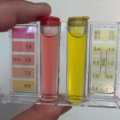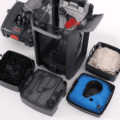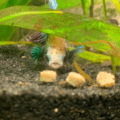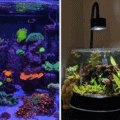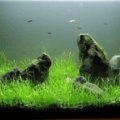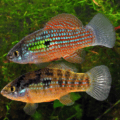When it comes to setting up a fish tank, one of the most important considerations is its size. A larger tank provides more space for your aquatic friends to thrive and allows for a more visually appealing display. In this article, we will delve into the specific dimensions and benefits of a 125 gallon fish tank, as well as provide insights on factors to consider, installation tips, maintenance, troubleshooting, and even options for upgrading.

Understanding the Capacity of a 125 Gallon Fish Tank
Before we explore the size of a 125 gallon fish tank, let’s talk about what a gallon represents in the world of fishkeeping. A gallon is a unit of measure used to determine the volume of water a tank can hold. In the case of a 125 gallon tank, it refers to the total capacity of the tank in gallons.
A standard 125 gallon fish tank typically measures 72 inches long, 18 inches wide, and 22 inches tall. These dimensions create ample space for your aquatic pets to swim and explore their environment. It’s important to note that specific tank models may have slight variations in size, so it’s always a good idea to check the manufacturer’s specifications.
Select a tank with a built-in overflow box for streamlined filtration; this keeps your water pristine, allowing you to house the most fish possible. A 125-gallon fish tank offers a spacious environment to create a stunning aquatic display.
Consider the weight (over 1000 pounds when filled) and choose a heavy-duty stand designed for this capacity. Opt for a tank built with tempered glass for its strength and scratch-resistance. A built-in overflow box ensures efficient filtration, keeping your water crystal clear.

Benefits of Owning a 125 Gallon Fish Tank
Investing in a 125 gallon fish tank comes with several advantages. Firstly, the spaciousness of this tank allows for a diverse range of fish species to coexist comfortably. From smaller schooling fish to larger cichlids or even a combination of both, you have plenty of options to create a vibrant and harmonious underwater community.
Another benefit is the enhanced visual appeal and display possibilities. With more room to work with, aquarists can create breathtaking aquascapes and showcase a variety of plants, rocks, and driftwood. The larger size also means that you can include larger fish species, such as angel fish or Oscars, which can become the focal point of your tank.
Flexibility for aquascaping and decoration is another advantage offered by a 125 gallon tank. This size provides the freedom to arrange and rearrange the elements within your tank, resulting in a dynamic and visually pleasing environment.
Additionally, a 125 gallon tank allows for the potential inclusion of larger aquatic plants. These plants not only provide aesthetic appeal but also contribute to the overall health and balance of the tank by absorbing excess nutrients and producing oxygen.

Factors to Consider Before Setting Up a 125 Gallon Fish Tank
Before diving into the world of a 125 gallon fish tank, there are a few important factors to consider. First and foremost, ensure that you have a suitable space to accommodate the tank. Its dimensions require careful planning to ensure a sturdy and level surface that can support the weight of the tank when filled with water and decorations.
Assessing the strength of the floor or support surface is crucial to avoid any potential accidents or damage. Always consult with a professional if you are unsure about the structural integrity of the chosen location.
Another crucial consideration is the amount of water the tank can hold. A 125 gallon tank not only requires a significant amount of water but also adds weight to the setup. Make sure the floor can bear the load and consider the accessibility of water sources for filling and regular maintenance.
Additionally, you need to factor in the equipment requirements and ongoing maintenance. Adequate filtration, heating, and lighting systems are essential for the health of your fish and the overall ecosystem. Routine cleaning, water changes, and monitoring water parameters are also necessary to maintain optimal conditions for your aquatic inhabitants.
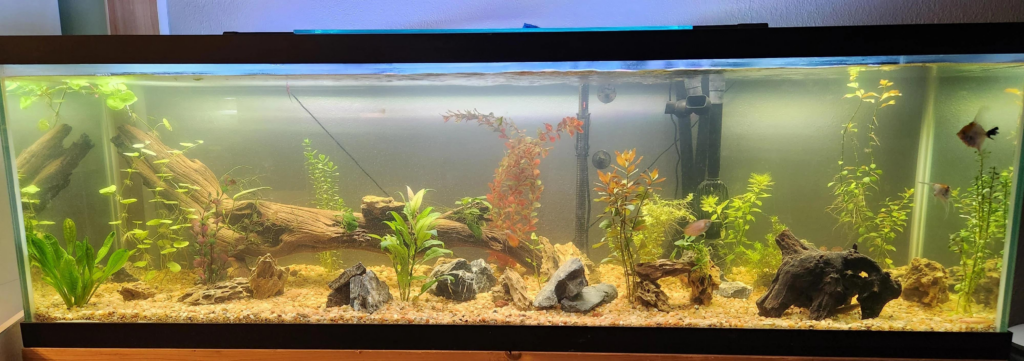
Choosing the Ideal Location for a 125 Gallon Fish Tank
Once you have considered the practical aspects of setting up a 125 gallon fish tank, finding the ideal location becomes crucial. Natural light availability should be assessed to prevent excessive algae growth. Placing the tank away from direct sunlight can help maintain the balance of your tank’s ecosystem.
Furthermore, evaluating temperature fluctuations and stability is important. Avoid placing the tank near drafty areas or locations prone to sudden temperature changes. Stability in temperature helps to keep your fish stress-free and healthy.
When selecting a location, consider access for maintenance and viewing pleasure. You want to be able to enjoy your aquarium effortlessly and carry out routine tasks comfortably. Easy access also makes it more convenient to perform required maintenance, such as cleaning the tank and changing filters.
Lastly, ensure proper ventilation and proximity to electrical outlets. Good airflow around the tank helps prevent the buildup of humidity, which can cause issues such as condensation or mold. Additionally, proximity to electrical outlets ensures that your equipment can be easily plugged in without the need for excessive cords or extension cables.
Plan Your Dream Setup
To visualize your tank, search for picture of 125-gallon setups that inspire you. Decide between a freshwater or saltwater environment, which will influence your choice of fish. The number of fish you can keep depends on their size and temperament, so research carefully to avoid overstocking. While Top Fin is a popular brand for accessories, look for other well-regarded manufacturers specializing in large tanks – check their average rating for quality assurance. Powerful lighting is crucial, especially for saltwater systems with corals. LED lights offer customization and energy efficiency.

Installing and Setting Up a 125 Gallon Fish Tank
Now that you have chosen the perfect location for your 125 gallon fish tank, it’s time to start the installation process. First, thoroughly clean the tank to remove any residue or debris that may have accumulated during transportation.
Next, add a suitable substrate to the bottom of the tank. Gravel, sand, or specialized aquatic soil can be used depending on the type of aquarium you are planning to create. Remember to rinse the substrate thoroughly before adding it to prevent cloudiness in the water.
Once the substrate is in place, it’s time to add decorations and aquascaping elements. Rocks, driftwood, and artificial plants can be arranged to create a visually appealing underwater landscape. Ensure that all elements are thoroughly cleaned before adding them to the tank to maintain water quality.
After the decorations are in place, introduce water to the tank while taking care to avoid disturbing the substrate or displacing any decorations. Prior to introducing your aquatic pets, it’s crucial to cycle the tank properly to establish beneficial bacteria and ensure a stable environment for your fish. This process typically takes several weeks and involves monitoring ammonia, nitrite, and nitrate levels.
Finally, install the necessary equipment such as filtration systems, heaters, and lighting. These components are crucial for maintaining water quality, providing the ideal temperature for your fish, and promoting the growth of plants.

Maintaining a Healthy and Vibrant 125 Gallon Fish Tank
The key to keeping your 125 gallon fish tank thriving lies in regular maintenance. It’s essential to conduct regular water quality testing to monitor levels of ammonia, nitrite, nitrate, pH, and other parameters. This allows you to take corrective measures promptly and ensure a healthy and balanced ecosystem.
Implementing a proper feeding schedule and appropriate portion sizes is crucial for the health of your fish. Overfeeding can lead to water pollution and potential health problems. Monitoring your fish’s behavior and appearance can help you identify any signs of illness or stress, and take action if needed.
Regular tank maintenance, such as cleaning filters and performing water changes, helps remove debris and maintain water quality. Additionally, controlling algae growth through appropriate lighting schedules and preventing excessive nutrients from entering the tank helps to avoid complications associated with an imbalanced ecosystem.
Adding Fish and Other Aquatic Life to a 125 Gallon Fish Tank
When adding fish and other aquatic life to your 125 gallon fish tank, thorough research is essential to ensure compatibility. Check each species’ specific requirements in terms of water parameters, temperature, and behavior before introducing them to the tank.
Gradually acclimate new fish to prevent stress and aggression among tank inhabitants. Monitor their behavior closely, especially during the initial days, to ensure they are adapting well to their new environment. It’s also important to maintain a balanced ecosystem by considering the preferences and needs of all tank occupants.
Troubleshooting Common Issues with a 125 Gallon Fish Tank
Despite your best efforts, you may encounter some common issues while maintaining a 125 gallon fish tank. Addressing water quality problems such as high ammonia levels, pH fluctuations, or excessive nitrate levels requires prompt action to prevent harm to your fish. Regular testing, proper filtration, and regular water changes can help resolve these issues.
Fish diseases and health issues can also arise. It’s important to recognize symptoms and take appropriate measures such as quarantine and treatment if necessary. Promptly addressing equipment malfunctions or failures is also crucial to maintaining the well-being of your fish and the overall tank environment.

Upgrading and Expanding a 125 Gallon Fish Tank
If you find yourself wanting to expand the capabilities of your 125 gallon fish tank, there are several options to consider. Assessing the feasibility of upgrading to a larger tank or increasing the water volume can provide even more space for your aquatic pets to flourish.
Expanding the available space within the tank can be achieved through the addition of extra aquariums, such as sumps or refugiums. These compartments can provide additional filtration, space for cultivating live plants, or even housing smaller species that require specific care.
Considering advanced options for filtration and lighting can further enhance the health and beauty of your tank. Upgrading to more efficient systems can help maintain water quality and create the optimal conditions for your fish and plants.
Conclusion
A 125 gallon fish tank offers an exciting opportunity to create a vibrant underwater world for a diverse range of fish species. From meticulously designing aquascapes to ensuring proper maintenance and troubleshooting, this size of tank presents numerous benefits and possibilities.
By understanding the specific size, factors to consider, installation tips, and ongoing maintenance requirements, you can provide a thriving environment for your aquatic companions. Whether you are a seasoned fishkeeper or a beginner, a 125 gallon fish tank can provide endless enjoyment and satisfaction.

